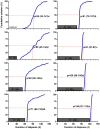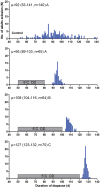Optimal low temperature and chilling period for both summer and winter diapause development in Pieris melete: based on a similar mechanism
- PMID: 23441185
- PMCID: PMC3575341
- DOI: 10.1371/journal.pone.0056404
Optimal low temperature and chilling period for both summer and winter diapause development in Pieris melete: based on a similar mechanism
Abstract
The cabbage butterfly, Pieris melete hibernates and aestivates as a diapausing pupa. We present evidence that the optimum of low temperature and optimal chilling periods for both summer and winter diapause development are based on a similar mechanism. Summer or winter diapausing pupae were exposed to different low temperatures of 1, 5, 10 or 15°C for different chilling periods (ranging from 30 to 120 d) or chilling treatments started at different stages of diapause, and were then transferred to 20°C, LD12.5:11.5 to terminate diapause. Chilling temperature and duration had a significant effect on the development of aestivating and hibernating pupae. The durations of diapause for both aestivating and hibernating pupae were significantly shorter when they were exposed to low temperatures of 1, 5 or 10°C for 50 or 60 days, suggesting that the optimum chilling temperatures for diapause development were between 1 and 10°C and the required optimal chilling period was about 50-60 days. Eighty days of chilling was efficient for the completion of both summer and winter diapause. When chilling periods were ≥90 days, the durations of summer and winter diapause were significantly lengthened; however, the adult emergence was more synchronous. The adaptive significance of a similar mechanism on summer and winter diapause development is discussed.
Conflict of interest statement
Figures



Similar articles
-
A comparison of photoperiodic control of diapause between aestivation and hibernation in the cabbage butterfly Pieris melete.J Insect Physiol. 2008 May;54(5):755-64. doi: 10.1016/j.jinsphys.2008.01.009. Epub 2008 Feb 6. J Insect Physiol. 2008. PMID: 18440018
-
Molecular characterization of three Hsp90 from Pieris and expression patterns in response to cold and thermal stress in summer and winter diapause of Pieris melete.Insect Sci. 2018 Apr;25(2):273-283. doi: 10.1111/1744-7917.12414. Epub 2017 Feb 1. Insect Sci. 2018. PMID: 27791340
-
Role of natural day-length and temperature in determination of summer and winter diapause in Pieris melete (Lepidoptera: Pieridae).Bull Entomol Res. 2012 Jun;102(3):267-73. doi: 10.1017/S0007485311000587. Epub 2011 Oct 26. Bull Entomol Res. 2012. PMID: 22030333
-
Water management by dormant insects: comparisons between dehydration resistance during summer aestivation and winter diapause.Prog Mol Subcell Biol. 2010;49:209-29. doi: 10.1007/978-3-642-02421-4_10. Prog Mol Subcell Biol. 2010. PMID: 20069411 Review.
-
Molecular Mechanisms of Winter Survival.Annu Rev Entomol. 2023 Jan 23;68:319-339. doi: 10.1146/annurev-ento-120120-095233. Epub 2022 Oct 7. Annu Rev Entomol. 2023. PMID: 36206770 Review.
Cited by
-
Effect of winter cold duration on spring phenology of the orange tip butterfly, Anthocharis cardamines.Ecol Evol. 2015 Nov 7;5(23):5509-20. doi: 10.1002/ece3.1773. eCollection 2015 Dec. Ecol Evol. 2015. PMID: 27069602 Free PMC article.
-
Characterization of Three Heat Shock Protein Genes in Pieris melete and Their Expression Patterns in Response to Temperature Stress and Pupal Diapause.Insects. 2022 May 5;13(5):430. doi: 10.3390/insects13050430. Insects. 2022. PMID: 35621766 Free PMC article.
-
Expression of alternative developmental pathways in the cabbage butterfly, Pieris melete and their differences in life history traits.Ecol Evol. 2019 Oct 21;9(21):12311-12321. doi: 10.1002/ece3.5731. eCollection 2019 Nov. Ecol Evol. 2019. PMID: 31832162 Free PMC article.
-
Evolutionary Shift of Insect Diapause Strategy in a Warming Climate: An Intra-Population Evidence from Asian Corn Borer.Biology (Basel). 2023 May 24;12(6):762. doi: 10.3390/biology12060762. Biology (Basel). 2023. PMID: 37372047 Free PMC article.
References
-
- Denlinger DL (2002) Regulation of diapause. Annual Review of Entomology 47: 93–122. - PubMed
-
- Koštál V (2006) Eco-physiological phases of insect diapause. Journal of Insect Physiology 52: 113–127. - PubMed
-
- Hodek I (2002) Controversial aspects of diapause development. European Journal of Entomology 99: 163–173.
-
- Tauber MJ, Tauber CA, Masaki S (1986) Seasonal adaptions of insect. Oxford University Press, New York and Oxford.
-
- Danks HV (1987) Insect dormancy: an ecological perspective. Biological Survey of Canada. Monograph Series No 1. Ottawa.
Publication types
MeSH terms
LinkOut - more resources
Full Text Sources
Other Literature Sources

